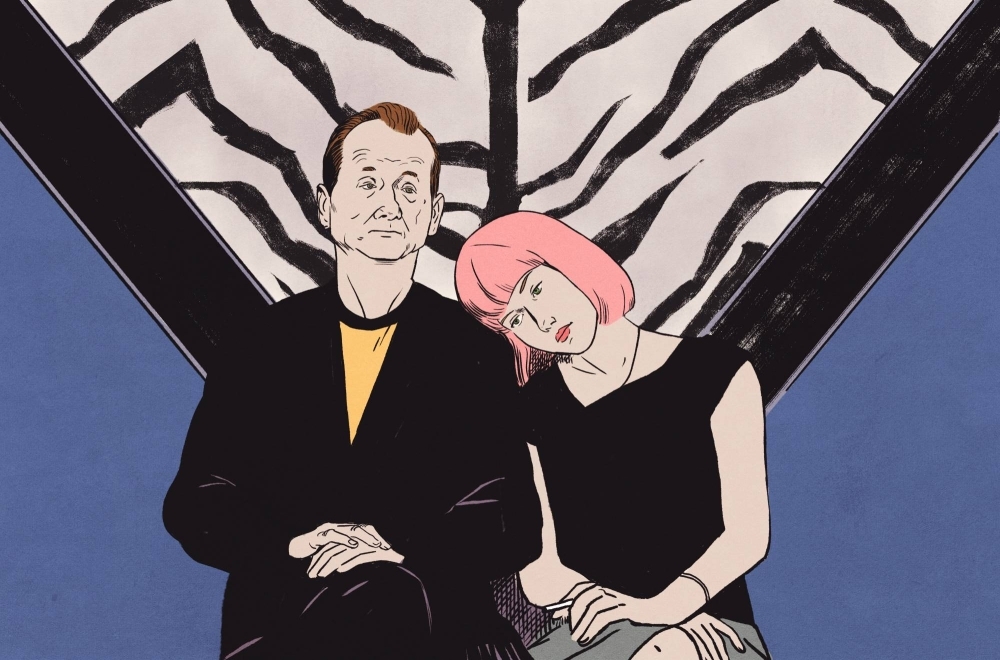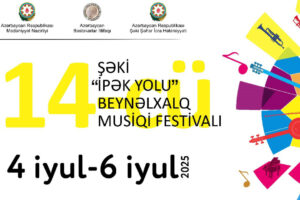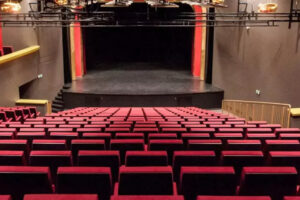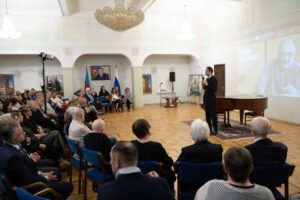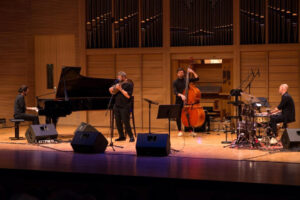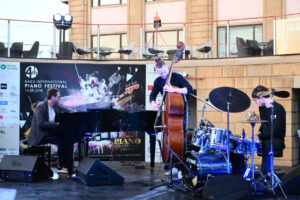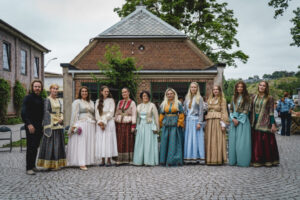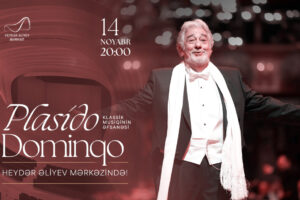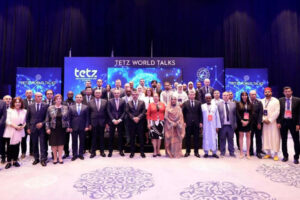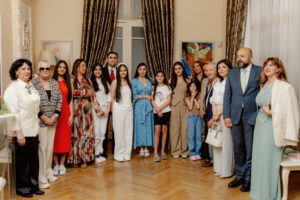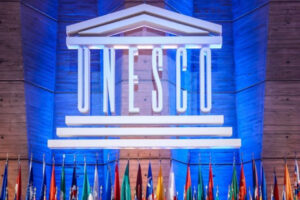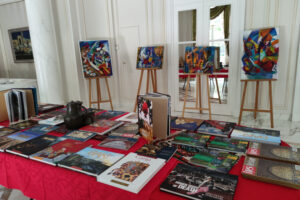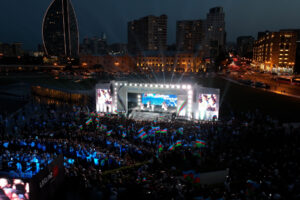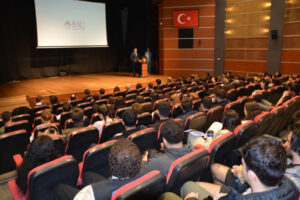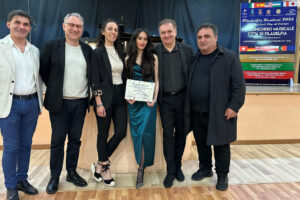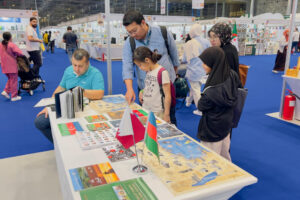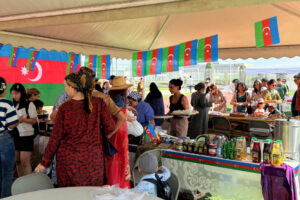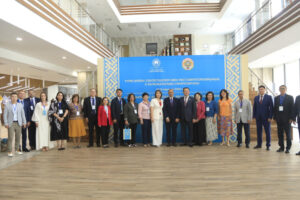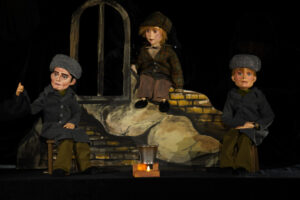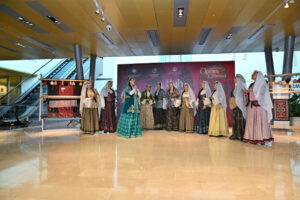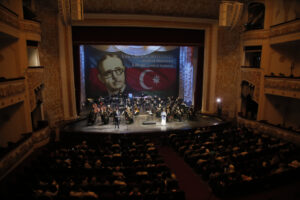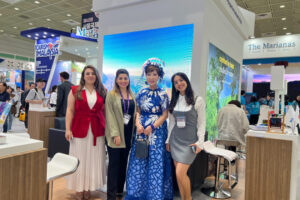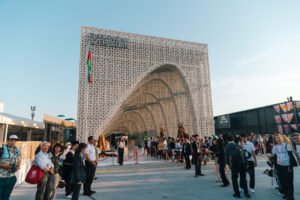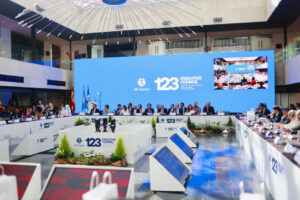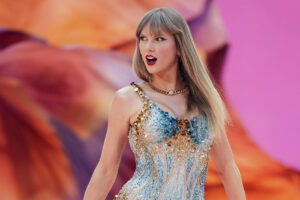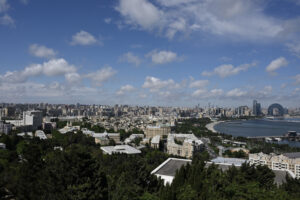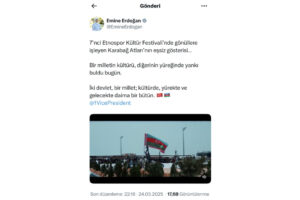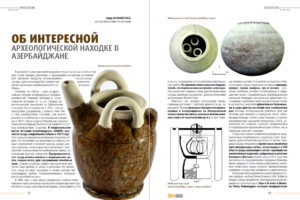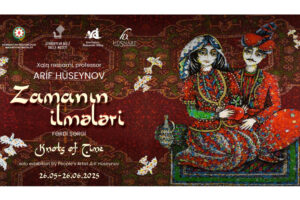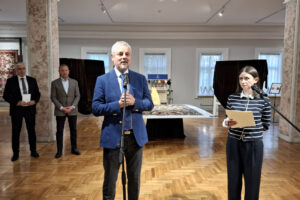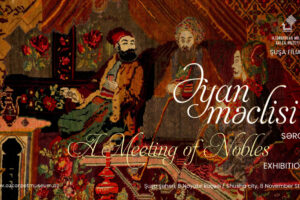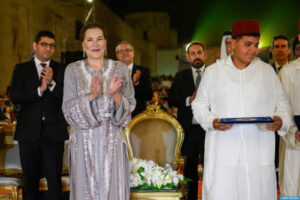Tokyo, 12 September, /AJMEDIA/
In the autumn of 2003, Japan was having a bit of a moment at the movies. That October, cinema audiences were treated to the spectacle of Uma Thurman clashing with the Crazy 88 yakuza gang in Quentin Tarantino’s “Kill Bill: Vol. 1.” A few weeks later, Tom Cruise could be seen getting in touch with his warrior spirit in Edward Zwick’s period epic, “The Last Samurai.”
But first out of the blocks was “Lost in Translation,” the sophomore feature by Sofia Coppola — a celebrity kid already well on her way to becoming a celebrated filmmaker in her own right.
Released in U.S. theaters on Sept. 12, this tale of a brief encounter between two lonely souls at a luxury hotel in Tokyo was a resounding critical and commercial success. Produced on a modest $4 million budget, it went on to pick up four Academy Award nominations, including for best picture, with Coppola taking home the Oscar for best original screenplay.
The director, a frequent visitor to Tokyo, had intended the movie to be a love letter to the city. Not everyone took it that way, but even the film’s most ardent detractors would have to admit that it remains one of Hollywood’s more enduring depictions of the Japanese capital. Shooting with a handheld Aaton camera — and without obtaining permits — Coppola and cinematographer Lance Acord captured a vibe that, 20 years on, people are still chasing.
“Before, people came to Tokyo for work,” says writer and editor Kunichi Nomura, a friend of Coppola’s who appears briefly in the film and also helped out behind the scenes. “But after ‘Lost in Translation,’ people started to come here for a holiday.”
An intimate, chaotic shoot
“Lost in Translation” is about two people meeting in an unfamiliar city and forming a brief, intense emotional bond that teeters between friendship and romance. One of them, Bob (Bill Murray), is a washed-up Hollywood actor in Tokyo to shoot a lucrative commercial for Suntory whisky. The other, Charlotte (Scarlett Johansson), is a young college graduate who has tagged along with her successful photographer husband (Giovanni Ribisi).
Whereas most international productions at the time blundered into town with gargantuan lighting rigs and bloated budgets, Coppola tried to stay light on her feet.
“She said that she wanted the film to feel as though it was filmed by her and a tiny, intimate crew of just friends — and we tried to make that happen as much as possible,” recalls Stephen Nomura Schible, one of the movie’s co-producers. Born and raised in Tokyo, he was among a handful of people involved with the production who were highly proficient in both English and Japanese.
“It started out quite difficult, and it never really became easy until it was all over,” he says. “In Japanese, they say ‘kajiba no bakajikara.’ Where there’s a fire, people freak out, and then they find all these abilities that they have all of a sudden. I think my experience of working with the Coppolas was a bit like that: It was genius, but it was also trial by adrenaline … a trial by fire.”
“The first couple of days was really chaos,” agrees Takuro Ishizaka, now an established cinematographer, who worked as second camera assistant on the film. While shooting in central Shibuya, he remembers that Coppola and Acord would wander off to explore the area after finishing a take, leaving the rest of the crew scrambling to find them.
“We had to carry two cameras most of the time, but with just the one camera crew. So we had to carry all the film, and reload on the streets, and then it would start raining — madness.”
Official oversight was less stringent at the time, meaning that movie productions shooting on the streets of Tokyo often had to worry more about attracting the attention of the yakuza than getting reprimanded by the police. Ishizaka was with the production’s second unit — helmed by Coppola’s brother, Roman — when they had one such encounter with some local heavies.
“We decided to never talk in Japanese,” he says. “So all of us would be only talking in English — (pretending) we don’t speak Japanese. We would walk around, keep shooting, and they would keep chasing us.”
Coppola drew on her experiences visiting the city during the 1990s, when she started a Japan-only fashion brand, Milkfed, and also worked as a photographer. She recruited real-life friends and acquaintances, including Nomura, Hiroko Kawasaki (who worked as the film’s production consultant) and fashion designer Nobuhiko Kitamura, founder of the Hysteric Glamour brand.
Actress Akiko Monou — who is credited by her nickname, “P-chan” — recounts how she ended up taking part: “Whenever there was an interesting party, Kunichi would always call me up and tell me to come. One day he phoned me like that and said: ‘P, Sofia Coppola is coming to Japan to shoot a film. There’s a party scene, and they just want us to enjoy ourselves like we normally do.’ It was all really casual.”
The most vivid personality among the film’s party people is fashion editor Fumihiro Hayashi — or “Charlie,” as he was widely known — who had commissioned Coppola for some of her first photography assignments. He died in 2011 at the age of 46, but Monou still remembers him fondly.
“He was like an older brother to all of us,” she says, confirming that the gregarious character captured in the film was an accurate representation. “That’s really what he was like: He’d do wild, crazy things, but he was full of love, too — just a great guy.”
Monou was originally only supposed to appear in a club scene, for which she sported a fetching furry hat. Coppola took a liking to her, and asked the actress to come back for a karaoke scene, filmed at the Shibuya branch of Karaoke-kan.
“Everyone was drinking sake while we waited — just drinking normally and singing karaoke — so it was really true to life,” Monou says. “Sofia and her crew would be quietly discussing with Scarlett and the others, giving them proper directions, but we were just enjoying ourselves. I think that’s why the vibe feels so authentic.”
This chimes with Ishizaka’s memories of the shoot: “Everyone was very creative, and understood how to keep the atmosphere, not disturb it — keep working, keep letting them shoot,” he says. This didn’t sit well with some of the local production staff: “They were trying to force them to come up with: ‘What you gonna shoot? Where you gonna shoot?’”
Acord preferred to film in a documentary style, using shallow depth-of-field and minimal lighting. He achieved the movie’s distinctive look by shooting on high-speed Kodak film stock that he deliberately underexposed, then compensating for this when making the print, giving the images a soft, low-contrast texture that would be frequently imitated in the years to come.
“Lance was shooting all the time,” says Yuji Wada, who oversaw the film’s lighting department. “It didn’t matter if Sofia was there or not — when he really wanted to shoot, Scarlett or whatever, he was just shooting, without saying anything at all. No clapperboard, nothing.”
Nomura remembers that the production had difficulties finding suitable locations, after discovering that the hip nightspots Coppola had visited a few years earlier had all closed. The Harajuku store of fashion brand A.P.C. substituted for a trendy strip club; a house party scene was filmed at the Hysteric Glamour office.
“We had zero budget, so I had to ask all my friends for a favor,” he says.
One of the film’s biggest coups was getting Murray to appear on “Matthew’s Best Hit TV,” a cult late-night show presented by Matthew Minami, the garrulous alter ego of comedian Takashi Fujii. Coppola’s original script describes him as “the Johnny Carson of Japan” — a comparison that makes more sense when Schible reveals the director had originally hoped to land a spot on “Waratte Iitomo!” the long-running variety show hosted by TV heavyweight Kazuyoshi Morita, better known as “Tamori.”
(Fujii’s manager declined an interview request, but provided an emailed statement from Minami, who expressed his gratitude to Coppola for preserving him on film 20 years ago. “I was given a bottle of wine by the director to celebrate the completion of the film,” he wrote. “If I hadn’t drunk it with my agent, I wonder what it would taste like now.”)
Meet me at the bar
The most consequential casting choice, if you can call it that, was for the film’s main location. Coppola had stayed at the Park Hyatt Tokyo in Shinjuku before, and managed to secure permission to film at the hotel — something that had never happened prior or since. After its release, “Lost in Translation” turned the hotel’s 52nd-floor New York Bar into an essential stop on tourist itineraries; customers can still order a pink-hued “L.I.T” cocktail.
“I was working there during that time, and I clearly remember the changes there, day by day,” says Yasukazu Yokota, now the hotel’s Food & Beverage Manager. “It was already popular and loved by guests since opening, but after ‘Lost in Translation,’ I felt a big wave of people visiting because of the movie.”
He remembers being impressed by the “professionalism” of Coppola and her crew during the shoot.
“They managed to complete all the filming while our outlets were closed in the early hours of the morning, so we didn’t have to sacrifice anything with the hotel operation,” he says. “I cannot forget how sweet and gentle Bill Murray was and how he made people around him laugh all the time.”
(Coppola’s memory, in a 2013 interview with The Daily Beast, is slightly more colorful: “I remember (Bill) would throw the hotel housekeeper lady over his shoulder and walk around with her.”)
Culture clashes, big and small, are a running theme throughout “Lost in Translation.” In one famous scene, Bob has to appear in a Suntory TV commercial, but there’s a clear disconnect between the director’s verbose instructions and the sparse English translations given by his interpreter. Less hilariously, Bob later gets a visit from a sex worker hired by his Japanese hosts, who commands him to “lip (sic) my stockings.”
“When I read the script, and some of the Japanese read it, it was interesting,” says Ishizaka. Having moved to the United States at the age of 16 and worked in Hollywood, he understood how his native country could appear to a first-time visitor. However, “some of the crew … thought this whole thing was very insulting.”
“It clearly wasn’t a role for the local crew, for the most part, to express about those types of sensitivities — for better or for worse,” says Schible, who also admits to having felt uncomfortable about certain aspects of the script. “I think I always saw it as Sofia’s interpretation. It was obviously very personal, based on some of her real experiences, and she had a good knowledge of the local scene.”
There were cultural misunderstandings happening on both sides of the camera. The production was constantly having to navigate what Schible calls a “cultural/linguistic barrier.”
“What that basically meant was that everything takes twice as long, in terms of communications — if not more,” he explains. “Everything needs to be translated, the answer needs to be translated back, and that still didn’t have any effect on the fact that we only had 27 shooting days.”
Given his background in live TV comedy, Murray was accustomed to making things up on the fly. Much of the dialogue that made it into the final film was ad-libbed, smoothing out the occasional stiffness of Coppola’s original script.
“Bill was just great — he used anything,” Ishizaka recalls. “Whatever happened, he’d just keep going. Every day, it was so much fun watching him: ‘What’s he going to do next?’ And then Sofia was always like, ‘Hmm … something else?’”
However, there were limits to the actor’s patience. Schible recalls that Murray decided not to show up for work one day, having grown frustrated that the crew was never ready on time. The film’s star went off to watch Sheryl Crow perform at the Nippon Budokan instead, where Schible had to go and sheepishly fetch him back.
“Part of his whole performance was real — he was like, ‘What am I doing here? What the heck’s going on?’” Schible says. “And I think maybe that was part of Sofia’s genius, where the film kind of figured out a way to make itself, through the reality that we were in.”
One particularly tricky moment came during an emotionally strained scene between Bob and Charlotte, filmed at a shabu-shabu restaurant in the basement of the Shibuya Creston Hotel. Accounts of the incident vary, but what everyone can agree on is that someone — either the location manager or the restaurant’s owner — got antsy that the shoot was running way over schedule and switched off all the lights.
“I couldn’t stop laughing,” says Wada, as he recalls how Acord carried on shooting in the dark. “I thought: This guy is a genius!”
For all the complications, Schible says there was an upside to filming in Tokyo.
“God forbid, I don’t know what would have happened if the film was not shot in Japan,” he says. “We had a fantastic art department — which was all entirely local, except for the department head — and I don’t think they slept for days. Where else but — maybe Korea, I don’t know — but certainly not in Europe or not in North America are you going to get away with stuff like that.”
The film’s subsequent success seems to have taken everyone by surprise. “Lost in Translation” started with a limited theatrical release in the U.S., only later reaching Europe and Japan. It ended up making back nearly 30 times its original budget at the worldwide box office.
“Until I watched ‘Lost in Translation,’ I never thought this movie would become successful, to be honest,” says Nomura. “But after I watched it, I got it. Completely. It reminded me of when I went to New York for the first time. Every person who’s been abroad, on your own, staying there: You feel isolated, but then after a week, you feel like you are accepted. ‘Lost in Translation’ is about that feeling. It’s not about Tokyo, in the end.”
Coppola has continued to return to the city over the years. She brought her family for a celebration in 2019 that ended up in the same Shibuya karaoke booth that features in the film. More recently, she made a centennial anniversary tribute for House of Suntory, in which Nomura and a few other friends join a visiting Hollywood celebrity for drinks, with Keanu Reeves playing the guest of honor.
The influence of “Lost in Translation” still lingers, even if the city it captured feels increasingly distant from the present reality. Nomura decries the wave of large-scale redevelopment that’s transforming areas like Shibuya, replacing its messy but vibrant street-level culture with blocky skyscrapers that he compares to “Uniqlo clothes.”
“Do you think those ugly, big buildings would attract people around the world?” he asks. “Why people like Tokyo — or people loved ‘Lost in Translation’ and started to visit here — is because it was the right balance of chaos, you know?”
“I want everybody to rewatch the movie, and think about it again,” he says. “Is this the right direction we are taking, about changing the city?”
But perhaps it’s only appropriate that the setting for Coppola’s film should prove as fleeting as the relationship between Murray and Johansson’s characters. It was fun for a while. We’ll always have Suntory time.

